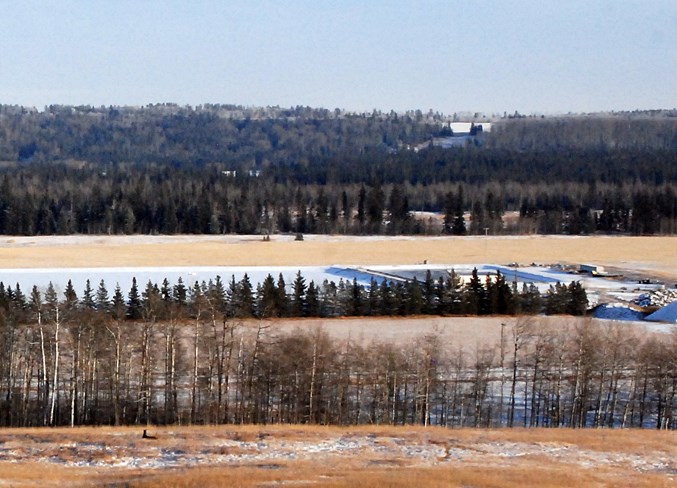Plans are progressing to ensure the municipality will be in compliance with updated environmental regulations for the quality of effluent discharged from Sundre’s wastewater treatment lagoon.
Provincial as well as federal rules mandate that towns which discharge into a river must complete a study that identifies wastewater treatment quality limits, states background information in council’s Jan. 7 meeting.
“The primary concern of the regulators is the presence of ammonia, and especially un-ionized ammonia, in the wastewater that may be harmful to fish, and phosphorous,” reads a report prepared by operations manager Jim Hall.
“The current lagoon system does not have the means to remove ammonia or phosphorous.”
For several years, the Town of Sundre has been preparing for the anticipated regulatory updates, culminating in a recommendation by the municipality’s engineer, CIMA+, to proceed with designing a submerged activated growth reactor (SAGR) pond that will be installed adjacent to the existing second and third ponds.
“That is a bioreactive type of pond that will consume and convert the un-ionized ammonia into something more palatable for the mixing zones,” Hall told council during the meeting, adding there is sufficient room on town-owned land to accommodate the upgrade.
The new pond will receive effluent from the third pond as the final step in the treatment process before being released back into the Red Deer River, he said.
“Alberta Environment and Parks will be reviewing those recommendations to see if there’s any issues in there with what we’ve produced as a future treatment schedule, and then they’ll come back with additional questions or comments, or say, ‘hey, go ahead,'" he said.
The operations manager added that he anticipates starting the pre-design phase for the upgrades this winter, with construction potentially starting some time in the spring or summer of 2020.
Although the municipality does not currently treat wastewater for un-ionized ammonia, Hall said the town’s infrastructure otherwise meets existing regulations.
The operations department has undertaken acute lethality tests such as the Lethal Concentration 50, in which a population of rainbow trout is placed in a sample of effluent with a required minimum survival rate of 50 per cent, states the report.
“We picked some of the worst toxicity times that we have, and we passed with 80 per cent and 100 per cent survival, which tells us our treatment is pretty good,” said Hall.
“Again, we’re not treating for un-ionized ammonia that can get into the Red Deer (river), which Environment Canada is after.”
The planning process also takes into consideration the possibility of subsequent years of low water flow in the Red Deer River, which could pose problems for the mixing zone with effluent not diluting as ideally as possible, he said.
“We sit on pristine waters. We’ve got to try and treat something that goes into some pristine waters for the 380,000 people downstream,” he said, adding flows frequently go up and down.
“The treated effluent will be designed for the historical low river level data to ensure compliance of the new regulations with increased population projections,” states his report.
Coun. Cheri Funke said a similar wastewater treatment system had been identified in a 2013 study at a cost of about $11 million and wondered what such an expense would amount to today.
“The SAGR system that we would be looking at currently is in around that $8- to $10-million” range, answered Hall.
He pointed out that, “additional monies may be required for other infrastructure upgrades to help with the treatment and/or capacities for the future.”
For the time being, Hall's report states the sewage lagoon relies on a three-pond system with bacteriologic conversion and continuous discharge of treated water to the Red Deer River. The system is designed to handle an average flow of a little more than 2,000 cubic metres of sewage on a daily basis. The current average flow from the town is about 1,300 cubic metres per day. Additionally, the facility’s septic receiving station accepts another roughly 300 cubic metres a day of regional wastewater from area vacuum trucking companies.
“A lagoon is a very difficult system, but it works. It’s Mother Nature’s way of cleaning stuff,” said Hall.
Coun. Richard Warnock wondered whether the new pond could be completed before the end of the 2020 construction season.
“It must take more than a summer?” he asked.
Hall said the system is basically a big pond that must be excavated and lined with a protective liner with the addition of aggregate and a header system. There are some time-consuming elements involved in that process, but not as much as, for example, more complicated mechanical plants used in cities, he said, confident the work can be completed in 2020.
“The design takes the time,” said Hall, adding that step will begin as soon as the municipality hears back from Alberta Environment and Parks.
Coun. Rob Wolfe’s motion to accept the report for information carried unopposed.



